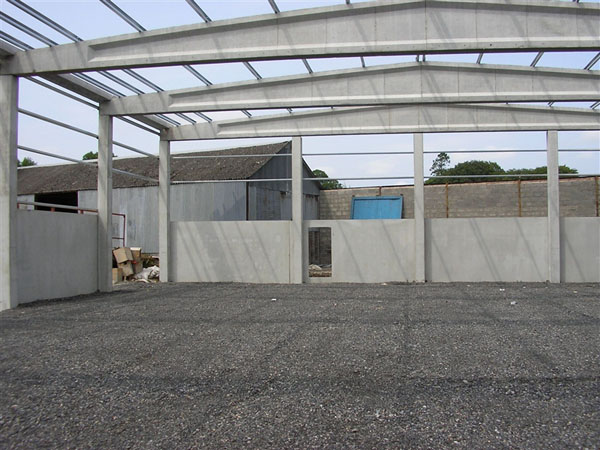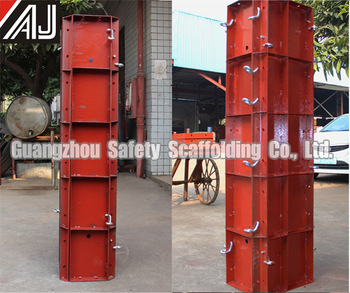@OutsourcedGuru Yes I did, but did not inspect it in detail. Thank you for reminding me.
@supertaz I still have the 28x28 extrusions from my K8200. When that works fine and I want to expand, I can switch to more solid ones 
@OutsourcedGuru Yes I did, but did not inspect it in detail. Thank you for reminding me.
@supertaz I still have the 28x28 extrusions from my K8200. When that works fine and I want to expand, I can switch to more solid ones 
I'm a big fan of concrete. I did three months down in Peru doing reconstruction work. And these guys do some inspiring work in this area. Another approach then is to 3D print a scaffolding like he's done in one of those photos. I wonder if it's possible to have a two-extruder design in which one of them is laying down a carbon fiber framework and the other is laying down concrete?
The way this discussion developed, my new printer frame may look like this 
 :
:

And that's bad, right? :laugh:
A tiny bit too huge...
Unfortunately, those 72" pipe sections are about $1,000 here in the states (minus any transportation costs). I guess in Mexico they're a quarter of that cost perhaps.
Wait a minute... what if you could 3D print a carbon fiber mesh as a framework for the precast pipe? And then simply cast them in concrete with that as a skeleton. I'm thinking SCC here. In my mind, it would be stronger than steel and more forgiving of earthquakes.
Or 3D print the framework panels as suitable for building adobe homes and walls?
I already decided myself for gold pressed latinum...
All the cool kids are doing that. ha
Dammit...you're stealing my ideas  How do you think I was planning to handle arbitrary forms and supports? Though CF isn't necessarily a requirement...it makes the most sense to use the cheapest support material that will work properly for any given segment , given just how much support material you'd have to use to print a building. That's the difference between reinforced concrete and regular concrete...to do reinforced concrete (at least rebar reinforced), you need to build the reinforcement structure in the section you're casting and then cast the section...which means you need mold walls and the like. The cool thing about printing them is that they are far less limited in shape for any given amount of labor, since the machine would be doing the vast majority of the labor.
How do you think I was planning to handle arbitrary forms and supports? Though CF isn't necessarily a requirement...it makes the most sense to use the cheapest support material that will work properly for any given segment , given just how much support material you'd have to use to print a building. That's the difference between reinforced concrete and regular concrete...to do reinforced concrete (at least rebar reinforced), you need to build the reinforcement structure in the section you're casting and then cast the section...which means you need mold walls and the like. The cool thing about printing them is that they are far less limited in shape for any given amount of labor, since the machine would be doing the vast majority of the labor.
I thought you had some fancy way of running rebar out of some contraption and then cutting it to length at the moment of truth with lasers (as strapped to sharks, of course).
Carbon fiber is really expensive as you suggest. But I've done some testing involving 3,000 pounds of pressure trying to squash a bicycle part and the stuff's pretty impressive. With the first round of trying-to-impress your average contractor or building inspector, I'm thinking that the words "carbon fiber" would shut some mouths. Later, I would sneak in PLA and run with that.
Back to the issue at hand though, I think I would 3D print in plastic about two inches' height worth of the mesh all around and then come right back over with the second extruder and drop cement at the same height as the upper-most plastic layer you just laid down. Only you'd be dropping 2 inches' worth of cement height this time. It will find the last cement layer and sink into the plastic framework if the mix is right. Great idea, btw.
Meh. I think it depends on what you're talking about here. CF itself is stronger pound for pound than steel, but it is very light. In order to have dimensional stability in multiple dimensions, you need multiple layers of CF, oriented in different directions. In order to make printable concrete reinforcement that's stronger and more resilient, you'd need a new material, probably some sort of nanostructure along the lines of carbon nanotubes, but they're short and very difficult to make. This has been the main issue with making a tether for a space elevator, though materials scientists are getting close. I just don't see how you'd be able to make a mesh in-situ, unless you used some sort of nanotube impregnated material that you were printing, but it'd be extremely abrasive.
I've built old-school adobe walls down in Peru. You basically go steal a bunch of bamboo, lay down a line of that vertically and then weave through that horizontally. The wet adobe gets smashed into both sides.
For a substantial wall like you'd find on a house, you just build it like two discrete walls and then I guess it gets later filled in from the top for the cavity in the middle.
oHo
oHo
oHo
oHo
oHo
oHo
oHo
It's like, you could lay down the H's seen here in plastic then come back over and run along a wide extrusion of cement. The viewpoint here is standing above the wall. It actually looks like it's a vertical representation, given how the cement blobs out.
I dunno about that. I'm thinking that as long as the plastic mesh interacts well with the cement in the same way that rebar would, then it's all good. So, you need projections.
LOL there's the real truth  Yes, the rebar sharks solve for non-CF reinforcement of the concrete itself. Support materials that I'm talking about are external, not internal, to give the form shape. I know there are concrete printers that work in layers, but the first earthquake (or colossal mouse fart) and BOOM!
Yes, the rebar sharks solve for non-CF reinforcement of the concrete itself. Support materials that I'm talking about are external, not internal, to give the form shape. I know there are concrete printers that work in layers, but the first earthquake (or colossal mouse fart) and BOOM!
Unfortunately, CF is strong in a single dimension, so for reinforcement purposes (unless you're talking about CF filled plastic), you'd need layers designed for dimensional stability in multiple axes. For CF filled plastics, they become too brittle over time because they're hygroscopic and concrete is full of water. The structure of the concrete is probably too large to be sufficiently bound by the CF content of the carrier plastic as it degrades, because the fill percentages aren't very high to begin with...great for 3D printing plastic parts, but not so much for reinforcing concrete, I'd think. It'd be interesting to experiment with, though to actually get some empirical numbers.
I do recall making a pitch to the owner of the plastic manufacturing plant that an untapped market segment would be to create (large) plastic forms for construction workers to replace the steel ones that they use now. But I could never get him to understand the concept and the value proposition.

And that's why people don't become wealthy by disrupting their industries, but rather get upset when their industry leaves them behind.
BTW...if you still have access to SCC and mixers, we could do some experiments...I've got a few spools of CF filled filaments, so I could print up some experimental reinforcements if we came up with a methodology. We'd need access to a much higher capacity load cell than I have, though.
@supertaz I don't, dude. I bet I could otherwise kick some butt in this area—I'm pretty good with concrete.
I'm in an apartment now and to be honest, I'm away from it because they've got about ten guys removing the roof at the moment.
Guess you shouldn't have been experimenting with concrete on the roof 
And here I was just now daydreaming about 3D printing those Spanish roof tiles...
...in concrete? I mean terra cotta hurts enough when it hits you in the head, but concrete's gonna leave a mark for sure! 
Actually, I was daydreaming a clay/adobe-printing mechanism... and then I thought about 3D-printed molds for same.